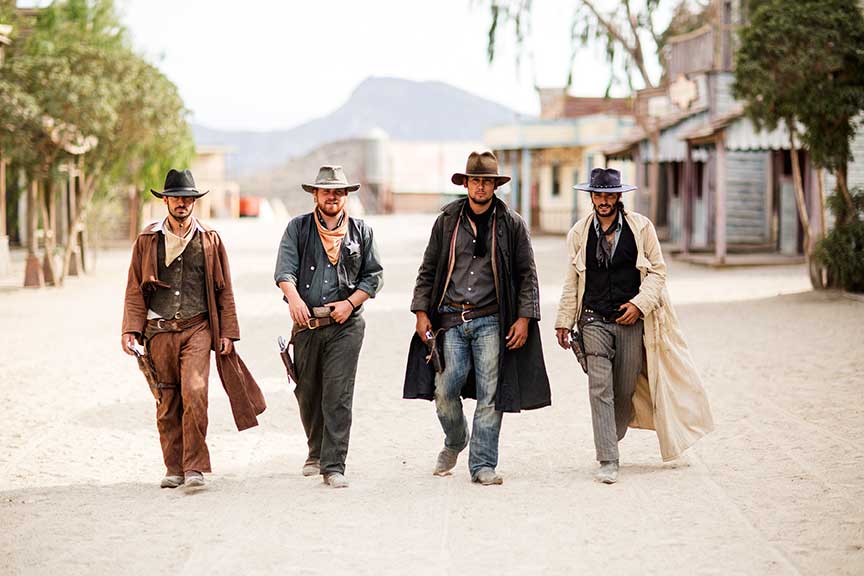Outlaws From the Wild West
by David Frank

If you've ever seen a Western movie, you're probably familiar with the image of outlaws riding across the dusty plains on their horses, robbing banks and causing havoc. But what are the facts about these notorious people? What did they do? How did they start their careers as outlaws? The following are some answers to these questions.
What Did Outlaws Do?
Outlaws often committed crimes such as murder, robbery and kidnapping. Because they would rob the settlers and miners of their hard-earned money, food, and supplies, they were considered a threat to society. As a result of the harsh conditions of life on the frontier, outlaws committed these kinds of crimes to survive and eventually thrive.
Despite their crimes, some people in the West viewed outlaws as heroes; in some cases these outlaws would fight corrupt politicians and military officials who targeted innocent citizens. The image of outlaw heroes made some people want to join them.
Outlaws lived in a different era and culture than we do today. In some cases, outlaws ran the area because of a lack of government officials. It took weeks for Washington DC and other areas to communicate since there was no email or text messaging.
Also, the way they spoke was different. Phrases like “I’m your huckleberry” meaning “I’m the one you want” or “Tenderfoot” meaning “new to a job or task” are just a few examples.
Their speaking also often included code words.
How Did Outlaws Start?
Outlaw can be used in a variety of contexts, but it generally refers to someone who doesn’t respect the law. As they do not seek legal justice, outlaws are often associated with vigilantism. Rather, they punish those who commit crimes against them and others by taking matters into their own hands.
People who live outside the law or break the law because they feel it will improve society at large are outlaws (this type is called a Robin Hood). People of this type lived in the Wild West, and were known as "outlaws" because they lived outside of civilization norm.
There were hundreds of outlaws, but here are four of the more famous ones:
Billy the Kid
Billy the Kid became involved with the Lincoln County War; he joined up with fellow outlaws like Jesse Evans and Tom Pickett. Due to his young appearance, people guessed he couldn't be more than 12 years old, hence his nickname "Billy the Kid." In spite of his youthful appearance, Billy was a fast gun in fights and soon gained a reputation for being one of the fastest guns in town.
After winning several battles against Sheriff Brady’s men at Fort Sumner during May/June 1877 (including one where he killed four deputies), the governor offered amnesty if they surrendered peacefully without bloodshed within three days time span, which both sides agreed upon.
Jessie James
Jessie James was a bank robber and train robber. He was born in Missouri in 1847, and grew up on the American frontier during the American Civil War.
In 1873, James joined his brother Frank's gang known as the “James Gang” or “Dalton Gang” after they had committed a series of robberies. They robbed banks in Coffeyville, Kansas; Northfield, Minnesota; and Abilene, Kansas, amongst others. They also worked with William Pinkerton to rob trains, such as one from Rock Island Line, which had $10 million worth of gold bars onboard, between Council Bluffs and Chicago.
El Paso Kid (Joe Carson)
El Paso Kid is notorious for being a member of the El Paso Gang, which operated during the Old West era. He was known as the most dangerous gunfighter of his time. The gang robbed trains, stagecoaches and banks across Texas and New Mexico territories throughout the 1870s until they were captured by U.S. Marshals near San Antonio in 1880, where he was sentenced to death by hanging.
Belle Starr
Arguably the most famous female outlaw is Belle Starr. She became known as the Bandit Queen after she began running gambling houses that catered to cowboys on cattle drives through Indian Territory (now Oklahoma).
These establishments were an early form of casinos and were profitable since there were no laws against them at the time. Some believe she helped hide her brother's criminal activities by using her taverns as his headquarters, where he held up stagecoaches traveling between Fort Smith, Arkansas and Dodge City, Kansas.
Conclusion
While the Wild West was a rough place to live, it was also a time of great adventure and opportunity. People who lived there faced constant challenges and dangers, but they rose to meet those challenges with courage, determination, and ingenuity. While they were criminals, their stories are what helped make the Old West part of American culture.
 >
>